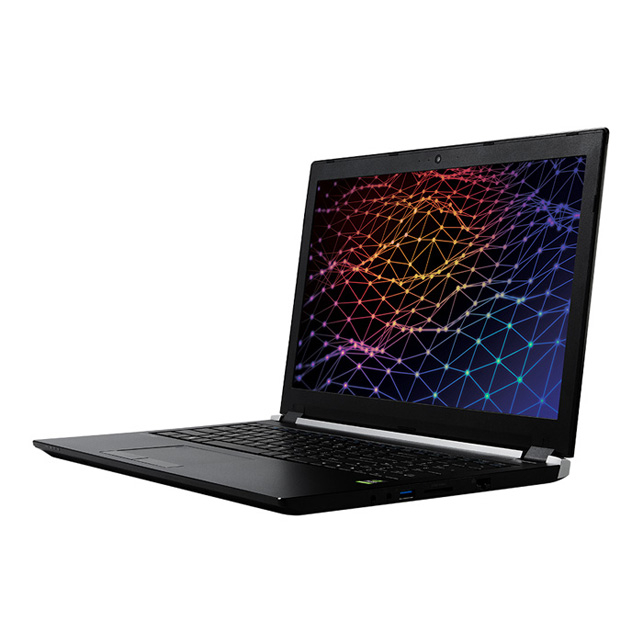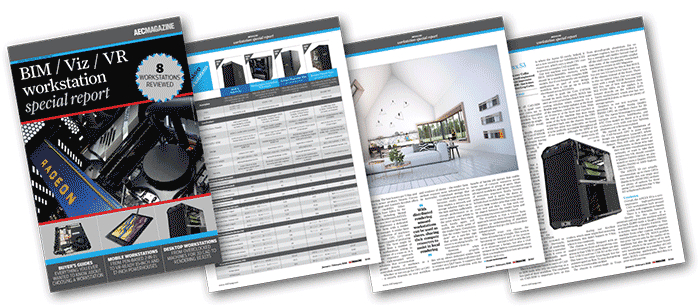This slimline 15-inch mobile workstation breaks all the rules by putting the powerful ‘VR Ready’ Quadro P4000 GPU at its heart, writes Greg Corke
If you want a mainstream 15-inch mobile workstation from Dell, Fujitsu, HP or Lenovo, you can only choose between an entry-level or mid-range pro GPU, up to the CAD-focused Quadro M2200. But if you need something more powerful – for design viz, Virtual Reality (VR) or GPU rendering, for example – then you’ll need to invest in a 17-inch machine.
The trouble is, 17-inch mobile workstations are not that practical for architects who love to travel. While the weight of these models has come down considerably over the years, you still have to lug around a sizeable unit, plus a power supply that alone can weigh as much as 1kg. You also have to accept shorter battery life.
Over the years, we’ve seen a few specialist mobile workstation manufacturers offer more powerful GPUs in a 15-inch form factor – the names Eurocom, MSI and Schenker spring to mind. But it’s PNY’s new PrevailPro P4000 that’s really caught our attention.
PNY is no stranger to workstations. It has been Nvidia’s official Quadro GPU partner since 2002. But this is the first time it has released a mobile workstation of its own. And with the PrevailPro P4000, it’s making quite a statement.
As the name suggests, it offers the significantly more powerful Quadro P4000 GPU. What it doesn’t tell you is that it delivers it in an extremely slimline chassis. At only 18mm thick and weighing 2.18kg, the PrevailPro P4000 is thinner and lighter than the Quadro M2200/M2000 class HP ZBook 15 or Dell Precision 7510. In fact, it’s virtually in the territory of the ultra-portable Dell Precision 5520 or HP ZBook Studio, both of which feature the entry-level Quadro M1200M GPU.
All of the mobile workstations mentioned above should be fine for 3D CAD, but the PNY PrevailPro P4000 gives you a very welcome boost for real-time visualisation or GPU rendering. It also has the potential to take your designs into Virtual Reality (VR).
We say potential since, although the machine is branded ‘VR Ready’, it won’t have enough GPU power for all pro VR workflows. In addition, it’s important to note that the Quadro P4000 is a special 80W ‘Max Q’ design clocked slightly slower than the standard 100W Quadro P4000 found in 17-inch mobile workstations.
Regardless, this is a powerful GPU and to find out where its VR limits might lie, we tested with a couple of pro VR applications using an Oculus Rift. We achieved flicker-free navigation with all of our Autodesk Revit Live datasets. In Autodesk VRED Professional, however, while it worked fine with small models it became unusable with larger automotive scenes or when anti-aliasing was turned on. However, we have found this to be the case with any Quadro P4000 GPU – desktop or mobile.
Product specifications
■ Intel Core i7-7700HQ 2.8GHz, 3.8GHz Turbo) (4 cores, 8 threads)
■ 32GB (2 x 16GB) DDR4 2,400MHz
■ Nvidia Quadro P4000 (8GB) (Max Q) (385.90)
■ 512GB M.2 NVMe SSD + 2TB 2.5-inch HDD
■ 15.6-inch IPS UHD (3,840 x 2,160)
■ 380 x 249 x 185mm 2.18kg
■ Microsoft Windows 10 Pro
■ 3 year Next Business Day on-site service
CPU benchmarks (single threaded) Seconds (smaller is better)
■ SolidWorks 2015 IGES export (single threaded): 111
CPU benchmarks (single threaded) Seconds (smaller is better)
■ Luxion KeyShot 6.1 render test (multi threaded): 828
■ V-Ray render benchmark (CPU) (multi threaded): 188
GPU compute benchmark Seconds (smaller is better)
■ V-Ray render benchmark (GPU): 121
3D graphics benchmarks (3D CAD) Score (bigger is better)
■ SPECapc for SolidWorks 2015 (shaded + edges): 4.27 (test run at 4K)
■ SPECapc for SolidWorks 2015 (RealView + shadows): 7.68 (test run at 4K)
■ SPECapc for SolidWorks (RealView + shadows + AO): 22.14 (test run at 4K)
■ SPECapc for PTC Creo 3.0 (shaded + edges): 7.32 (test run at 4K)
■ SPECapc for PTC Creo 3.0 (reflection): 11.5 (test run at 4K)
3D graphics benchmarks (design viz) Frames Per Second (FPS) (bigger is better)
■ LumenRT (hotel model) (FPS): 18 (test run at 4K)
■ LumenRT (roundabout model): 9 (test run at 4K)
■ Autodesk LIVE (Villa Enhanced model): 46 (test run at 4K)
■ Autodesk VRED Professional (AA off): 19 (test run at 4K)
■ Autodesk VRED Professional (AA medium):11 (test run at 4K)
■ Autodesk VRED Professional (AA ultra high ): 4 (test run at 4K)
3D graphics benchmarks (VR) Frames Per Second (FPS) (bigger is better)
■ VR Mark (Orange): 139.04 (VR resolution
■ VR Mark (Blue): 25.86 (VR resolution)
■ VR Mark (Cyan): 60.00 (VR resolution)
The PNY PrevailPro P4000 comes with a beautiful 15.6” UHD (3,840 x 2,160) display with bright colours and wide viewing angle. However, the downside of having greater clarity is the potential impact on 3D performance. While it performed extremely well in Creo, SolidWorks and Revit, in viz and game engine applications, where the GPU plays a much more important role, you could see the impact of having to render four times as many pixels.
For example, in Autodesk VRED, when displaying our test model with medium anti-aliasing, we recorded a frame rate of 11 FPS, which is not ideal. Viewing the same model at FHD (1,920 x 1,080) more than doubled the frame rate to a more acceptable 23 FPS.
The beauty of the PrevailPro P4000 is that you are able to change the resolution to FHD and all the icons and toolbars remain crisp. This is not often the case on other 4K mobile workstations, so having this flexibility is great as you can prioritise performance over pixel density as and when workflows require.
Having this much GPU power does mean there is a little trade-off when it comes to the CPU. The Intel Core i7-7700HQ is quad core, but the base frequency of 2.8GHz and Turbo of 3.8GHz is a little slower than the Intel Core Xeon E3-1535M v6 (3.10GHz – 4.20GHz) you can specify in mainstream 15-inch mobile workstations.
The Core i7-7700HQ still performed well in our single-threaded SolidWorks IGES export test and multi-threaded Luxion KeyShot render test, where it managed to maintain a clock speed of 3.4GHz. Longer duration renders saw this drop a little to 3.2GHz.
Cooling an 80W GPU and a 45W CPU is a big challenge in any mobile workstation, let alone one as slender as the PrevailPro P4000. PNY has employed three fans for this job – one assigned to the CPU and two to the GPU (at least, this is what we presume, since opening the chassis invalidates your warranty).
As one would anticipate, fan noise is significant, over and above the levels you’d expect from a mainstream 15-inch mobile workstation, but never too distracting.
The main chassis is pretty solid but the slender plastic display panel is a little flimsy. It’s certainly not the kind of laptop you could pick up by the screen, as I’ve seen Lenovo representatives do with ThinkPad mobile workstations.
There’s also a tiny bit of flex in the keyboard, but it does have a numeric keypad, useful for engineering calculations. The trackpad is good and there is a built-in fingerprint reader for security. Battery life is OK, with the 4-cell, 55WH Li-Polymer battery lasting 115 minutes in the GPU/CPU-hungry PC Mark test. It will last significantly longer in less demanding workflows.
The machine is well set up for external displays with two mini DisplayPort and an HDMi, the current standard for VR headsets. There are only three USB 3.1 Type A ports, however, but two USB 3.1 Type C ports can take up any slack.
32GB DDR4 2,400MHz memory is plenty for most design and engineering workflows, but half as much as a standard 15-inch can hold. There’s an ample 512GB of fast NVMe SSD storage supported by a 2TB HDD, a perfect combination in our mind.
Overall, we were very impressed with PNY’s mobile workstation debut. Packing in such a powerful GPU completely transforms the potential of the 15-inch mobile workstation. VR, in particular, is no longer off limits. The lightweight, slimline chassis is the icing on the cake, but one has to accept a trade-off in build quality compared to the Tier One manufacturers.
Price: £3,744 + VAT
This article is part of an AEC Magazine workstation special report. To read articles and reviews in this report click on the links below.
Desktop Workstation Buyer’s Guide
Essential advice for those looking to buy a workstation for product development
Boxx Apexx S3
The overclocked six core ‘Coffee Lake Core i7 CPU makes this CAD workstation fly
Workstation Specialists WS-1160A
AMD CPU and AMD GPU combine for a powerful workstation for CAD,viz and VR
AMD Radeon Vega GPUs
What does AMD’s Vega GPU architecture bring to CAD, VR, viz and GPU rendering?
Armari Magnetar R80 (Pre Production Unit)
This dual Intel Xeon Gold workstation delivers the goods in single and multi-threaded workflows
Boston Venom EPYC (Pre Production Unit)
Dual 32 core AMD Epyc CPUs make this rendering beast fly, but it’s at the expense of single threaded performance
Mobile workstation buyer’s guide
A rundown of the things to look out when buying a professional 3D laptop
Wacom MobileStudio Pro 16
Wacom’s legendary pen technology is embedded in a pro 3D tablet
HP ZBook x2 G4 (Pre-Production Unit)
This detachable 2-in-1 combines Wacom pen technology with a Quadro GPU for 3D CAD
Dell Precision 7720
With powerful processors, impressive cooling, good serviceability and excellent build quality, this 17” mobile workstation is hard to beat
Choosing a workstation? It’s not that straightforward
How to future proof your workstation to support new and emerging product development workflows
Rendering beyond the CAD workstation
When rendering work is on the cards, what’s the best way for a firm to get its machines and its workflows up to speed?
If you enjoyed this article, subscribe to AEC Magazine for FREE







